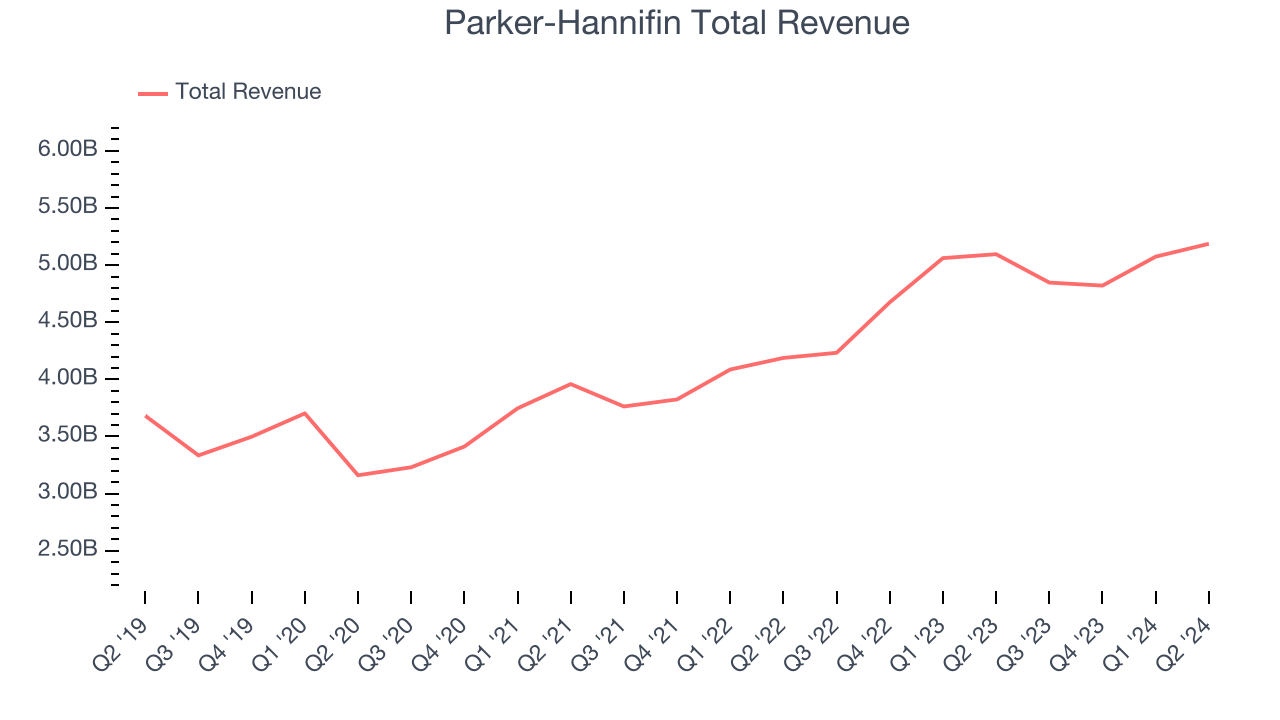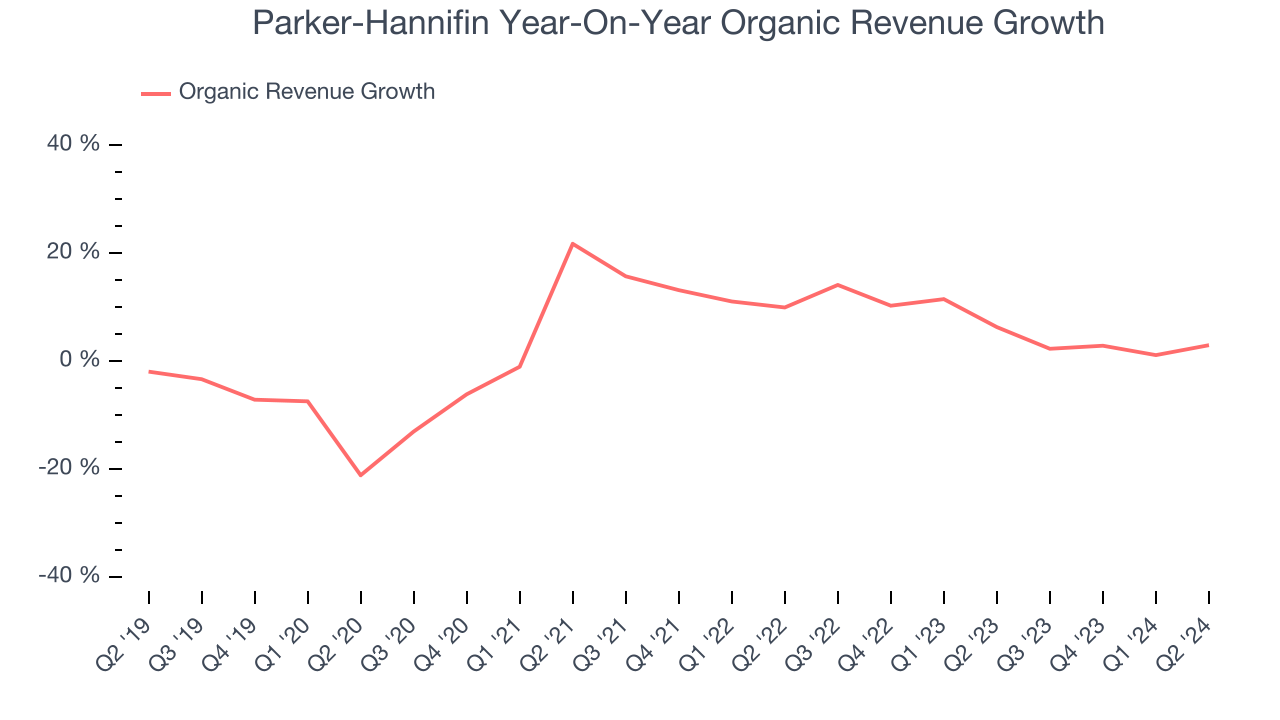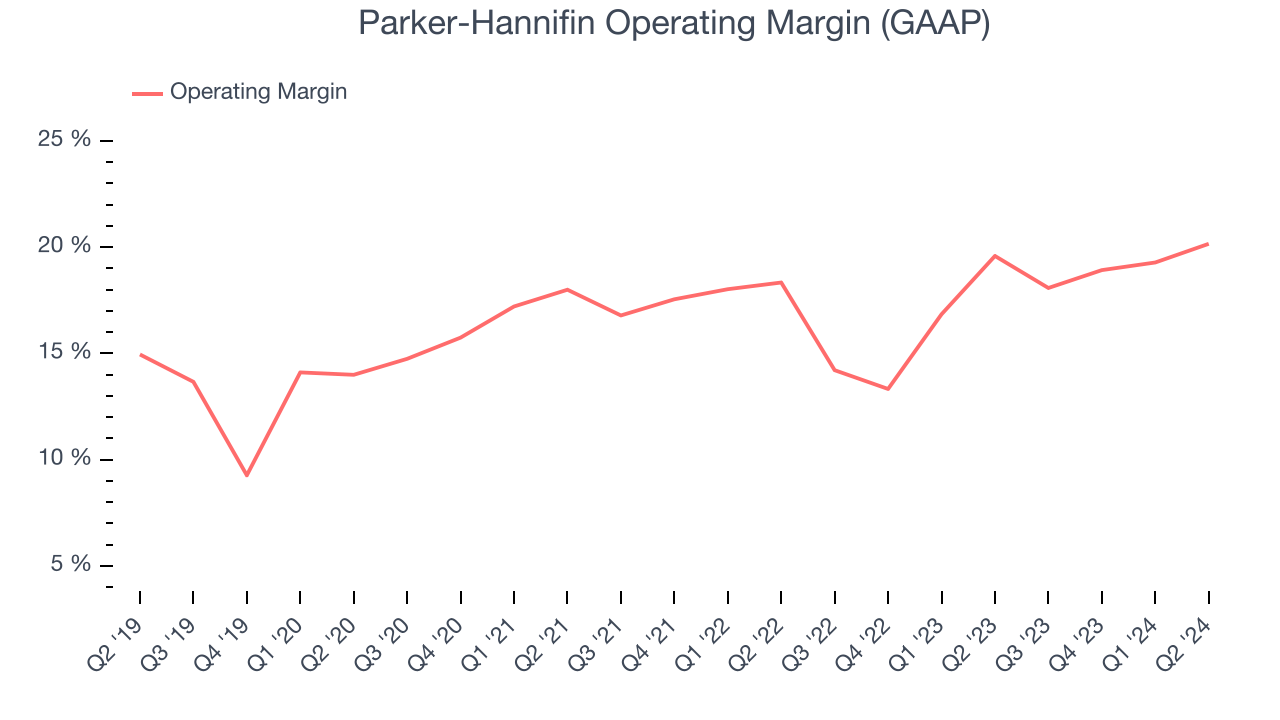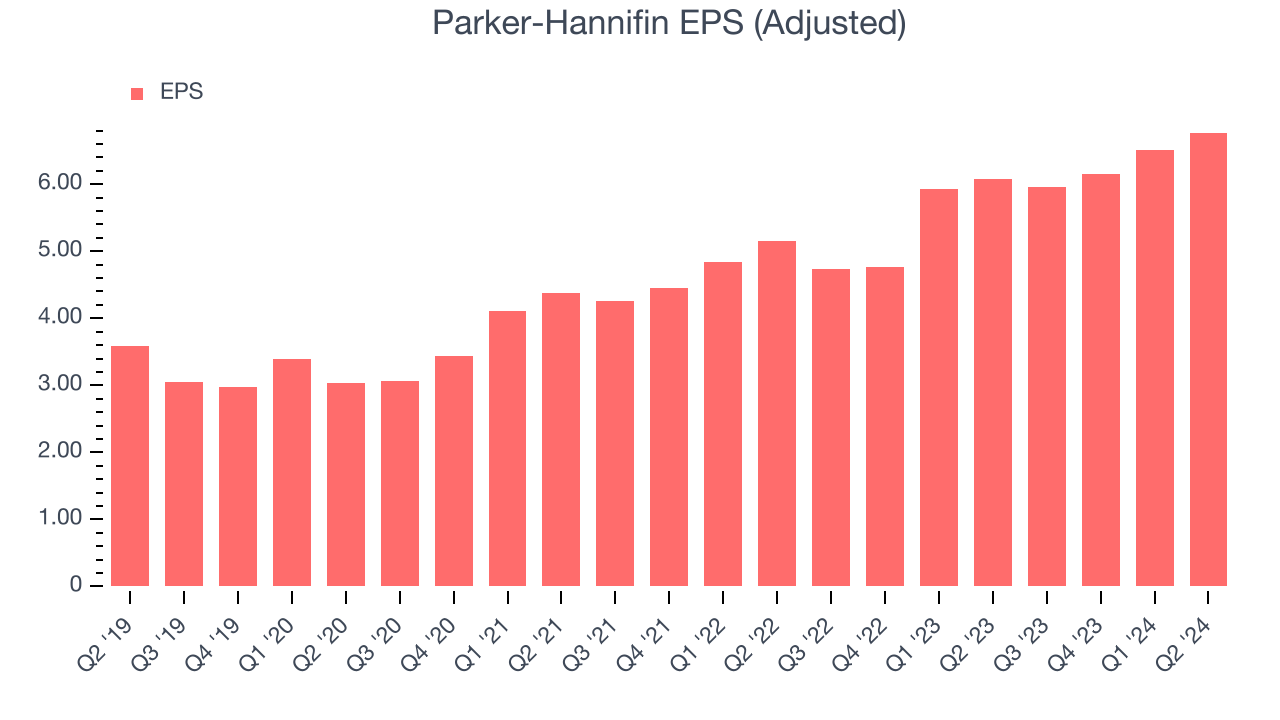Industrial machinery company Parker-Hannifin (NYSE:PH) announced better-than-expected results in Q2 CY2024, with revenue up 1.8% year on year to $5.19 billion. It made a non-GAAP profit of $6.77 per share, improving from its profit of $6.08 per share in the same quarter last year.
Is now the time to buy Parker-Hannifin? Find out by accessing our full research report, it's free.
Parker-Hannifin (PH) Q2 CY2024 Highlights:
- Revenue: $5.19 billion vs analyst estimates of $5.08 billion (2% beat)
- EPS (non-GAAP): $6.77 vs analyst estimates of $6.22 (8.8% beat)
- EPS (non-GAAP) guidance for the upcoming financial year 2025 is $26.65 at the midpoint, beating analyst estimates by 1.5%
- Gross Margin (GAAP): 35.9%, down from 38.3% in the same quarter last year
- EBITDA Margin: 26.3%, up from 23.2% in the same quarter last year
- Free Cash Flow of $1.12 billion, up 56.5% from the previous quarter
- Organic Revenue rose 3% year on year (6.4% in the same quarter last year)
- Market Capitalization: $65.88 billion
“We delivered an exceptionally strong fourth quarter capping another year of record performance,” said Chairman and Chief Executive Officer, Jenny Parmentier.
Founded in 1917, Parker Hannifin (NYSE:PH) is a manufacturer of motion and control systems for a wide variety of mobile, industrial and aerospace markets.
Gas and Liquid Handling
Gas and liquid handling companies possess the technical know-how and specialized equipment to handle valuable (and sometimes dangerous) substances. Lately, water conservation and carbon capture–which requires hydrogen and other gasses as well as specialized infrastructure–have been trending up, creating new demand for products such as filters, pumps, and valves. On the other hand, gas and liquid handling companies are at the whim of economic cycles. Consumer spending and interest rates, for example, can greatly impact the industrial production that drives demand for these companies’ offerings.
Sales Growth
A company’s long-term performance can indicate its business quality. Any business can put up a good quarter or two, but many enduring ones tend to grow for years. Regrettably, Parker-Hannifin's sales grew at a mediocre 6.8% compounded annual growth rate over the last five years. This shows it couldn't expand in any major way and is a tough starting point for our analysis. 
We at StockStory place the most emphasis on long-term growth, but within industrials, a half-decade historical view may miss cycles, industry trends, or a company capitalizing on catalysts such as a new contract win or a successful product line. Parker-Hannifin's annualized revenue growth of 12.1% over the last two years is above its five-year trend, suggesting its demand recently accelerated.
We can better understand the company's sales dynamics by analyzing its organic revenue, which strips out one-time events like acquisitions and currency fluctuations because they don't accurately reflect its fundamentals. Over the last two years, Parker-Hannifin's organic revenue averaged 6.5% year-on-year growth. Because this number is lower than its normal revenue growth, we can see that some mixture of acquisitions and foreign exchange rates boosted its headline performance. 
This quarter, Parker-Hannifin reported reasonable year-on-year revenue growth of 1.8%, and its $5.19 billion of revenue topped Wall Street's estimates by 2%. Looking ahead, Wall Street expects sales to grow 2.3% over the next 12 months.
Here at StockStory, we certainly understand the potential of thematic investing. Diverse winners from Microsoft (MSFT) to Alphabet (GOOG), Coca-Cola (KO) to Monster Beverage (MNST) could all have been identified as promising growth stories with a megatrend driving the growth. So, in that spirit, we’ve identified a relatively under-the-radar profitable growth stock benefitting from the rise of AI, available to you FREE via this link.
Operating Margin
Operating margin is a key measure of profitability. Think of it as net income–the bottom line–excluding the impact of taxes and interest on debt, which are less connected to business fundamentals.
Parker-Hannifin has been a well-oiled machine over the last five years. It demonstrated elite profitability for an industrials business, boasting an average operating margin of 16.7%.
Looking at the trend in its profitability, Parker-Hannifin's annual operating margin rose by 6.4 percentage points over the last five years, showing its efficiency has meaningfully improved.

This quarter, Parker-Hannifin generated an operating profit margin of 20.2%, in line with the same quarter last year. This indicates the company's cost structure has recently been stable.
EPS
We track the long-term growth in earnings per share (EPS) for the same reason as long-term revenue growth. Compared to revenue, however, EPS highlights whether a company's growth was profitable.
Parker-Hannifin's EPS grew at a spectacular 16% compounded annual growth rate over the last five years, higher than its 6.8% annualized revenue growth. This tells us the company became more profitable as it expanded.

We can take a deeper look into Parker-Hannifin's earnings to better understand the drivers of its performance. As we mentioned earlier, Parker-Hannifin's operating margin was flat this quarter but expanded by 6.4 percentage points over the last five years. This was the most relevant factor (aside from the revenue impact) behind its higher earnings; taxes and interest expenses can also affect EPS but don't tell us as much about a company's fundamentals.
Like with revenue, we also analyze EPS over a more recent period because it can give insight into an emerging theme or development for the business. For Parker-Hannifin, its two-year annual EPS growth of 16.5% is similar to its five-year trend, implying strong and stable earnings power.
In Q2, Parker-Hannifin reported EPS at $6.77, up from $6.08 in the same quarter last year. This print beat analysts' estimates by 8.8%. Over the next 12 months, Wall Street expects Parker-Hannifin to grow its earnings. Analysts are projecting its EPS of $25.40 in the last year to climb by 2.7% to $26.09.
Key Takeaways from Parker-Hannifin's Q2 Results
We were impressed by how significantly Parker-Hannifin blew past analysts' organic revenue expectations this quarter. We were also excited its revenue outperformed Wall Street's estimates. Zooming out, we think this was a good quarter with some key areas of upside. The stock traded up 6.3% to $545.68 immediately following the results.
Parker-Hannifin may have had a good quarter, but does that mean you should invest right now? When making that decision, it's important to consider its valuation, business qualities, as well as what has happened in the latest quarter. We cover that in our actionable full research report which you can read here, it's free.
